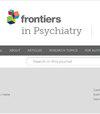Prospective associations between early childhood mental health concerns and formal diagnosis of neurodevelopmental disorders in adolescence
IF 3.2
3区 医学
Q2 PSYCHIATRY
引用次数: 0
Abstract
IntroductionUnderstanding associations between psychosocial development in early childhood and formal diagnosis of neurodevelopmental disorders (NDDs) in adolescence is critical for early identification and for tailoring interventions and support. This study investigated whether the Strengths and Difficulties Questionnaire (SDQ) scores in early childhood (4-5 years) predict mental health (MH) problems as evidenced by SDQ scores and formal diagnosis of NDDs in adolescence (16-17 years).MethodsThis study analysed data from a sample of 4968 children and adolescents using data from the Longitudinal Study of Australian Children. We used hierarchical regression models to determine the association between SDQ subscales and total scores at ages 4-5 years (primary exposure) and total SDQ scores and NDD diagnoses at ages 16-17 years (outcomes) whilst controlling for sociodemographic risk factors.ResultsEach unit increase in SDQ score at age 4-5 led to a rise in SDQ scores at age 16-17. Autism and ADHD diagnoses, female gender, lower maternal education, and financial hardship were associated with higher SDQ scores at age 16-17. Furthermore, parent reported SDQ at age 4-5 was linked to higher likelihoods of formal diagnoses of ADHD, autism, and ADHD/autism at age 16-17. Additionally, social determinants of health such as female gender, culturally and linguistically diverse (CALD) backgrounds, and financial hardship were associated with increased odds of ADHD, autism, and ADHD/autism diagnoses at age 16-17.ConclusionOur findings highlight the opportunity for early identification of transdiagnostic developmental and MH issues in the preschool period. Findings also emphasise the critical role of social determinants of health in the longitudinal trajectory of MH and NDDs and highlight the need for implementing early supports for improving peer relations and behavioural support strategies. If coupled with wrap around social care, early support strategies can enhance MH and wellbeing in adolescence and beyond.儿童早期心理健康问题与青春期神经发育障碍正式诊断之间的前瞻性关联
导言:了解幼儿期社会心理发展与青春期神经发育障碍(NDDs)正式诊断之间的关联,对于早期识别和定制干预与支持至关重要。本研究调查了幼儿期(4-5 岁)的优势与困难问卷(SDQ)得分是否能预测由 SDQ 得分和青春期(16-17 岁)正式诊断为 NDDs 所显示的心理健康(MH)问题。在控制社会人口风险因素的前提下,我们使用分层回归模型来确定 4-5 岁时 SDQ 分量表和总分(主要暴露)与 16-17 岁时 SDQ 总分和 NDD 诊断(结果)之间的关联。结果4-5 岁时 SDQ 分数每增加一个单位,16-17 岁时 SDQ 分数就会增加一个单位。自闭症和多动症诊断、女性性别、母亲教育程度较低和经济困难与 16-17 岁时 SDQ 分数较高有关。此外,4-5 岁时家长报告的 SDQ 与 16-17 岁时被正式诊断为多动症、自闭症和多动症/自闭症的可能性较高有关。此外,女性性别、文化和语言多样性(CALD)背景以及经济困难等健康的社会决定因素与 16-17 岁时被诊断为多动症、自闭症和多动症/自闭症的几率增加有关。研究结果还强调了健康的社会决定因素在精神健康和非智力障碍的纵向发展轨迹中的关键作用,并强调了实施早期支持以改善同伴关系和行为支持策略的必要性。如果再加上全方位的社会关怀,早期支持策略可以增强青少年时期及以后的心理健康和幸福感。
本文章由计算机程序翻译,如有差异,请以英文原文为准。
求助全文
约1分钟内获得全文
求助全文
来源期刊

Frontiers in Psychiatry
Medicine-Psychiatry and Mental Health
CiteScore
6.20
自引率
8.50%
发文量
2813
审稿时长
14 weeks
期刊介绍:
Frontiers in Psychiatry publishes rigorously peer-reviewed research across a wide spectrum of translational, basic and clinical research. Field Chief Editor Stefan Borgwardt at the University of Basel is supported by an outstanding Editorial Board of international researchers. This multidisciplinary open-access journal is at the forefront of disseminating and communicating scientific knowledge and impactful discoveries to researchers, academics, clinicians and the public worldwide.
The journal''s mission is to use translational approaches to improve therapeutic options for mental illness and consequently to improve patient treatment outcomes.
 求助内容:
求助内容: 应助结果提醒方式:
应助结果提醒方式:


